Join our reporter for the little-known, week-long celebration of Mahasivaratri in the Himalayan foothills, attended by some two hundred Deities paraded to Mandi town on the shoulders of the devotees from villages far and near. Hundreds of thousands of devotees converge for days of worship, music, dance, drama, sporting events and fun with family and friends.
By Dev Raj Agarwal, Himachal Pradesh
Prepare to reimagine everything you know about Sivaratri. Welcome to the town of Mandi in Himachal Pradesh, which suddenly comes to life after the long, cold months of winter in preparation for the International Sivaratri Festival 2024. In this grand event, some 200 Gods and Goddesses from temples all over the district of Mandi congregate in the town, along with hundreds of thousands of devotees gathering to seek blessings. Started by the town’s royal family in the 18th century the festival is today carried on by the district administration.
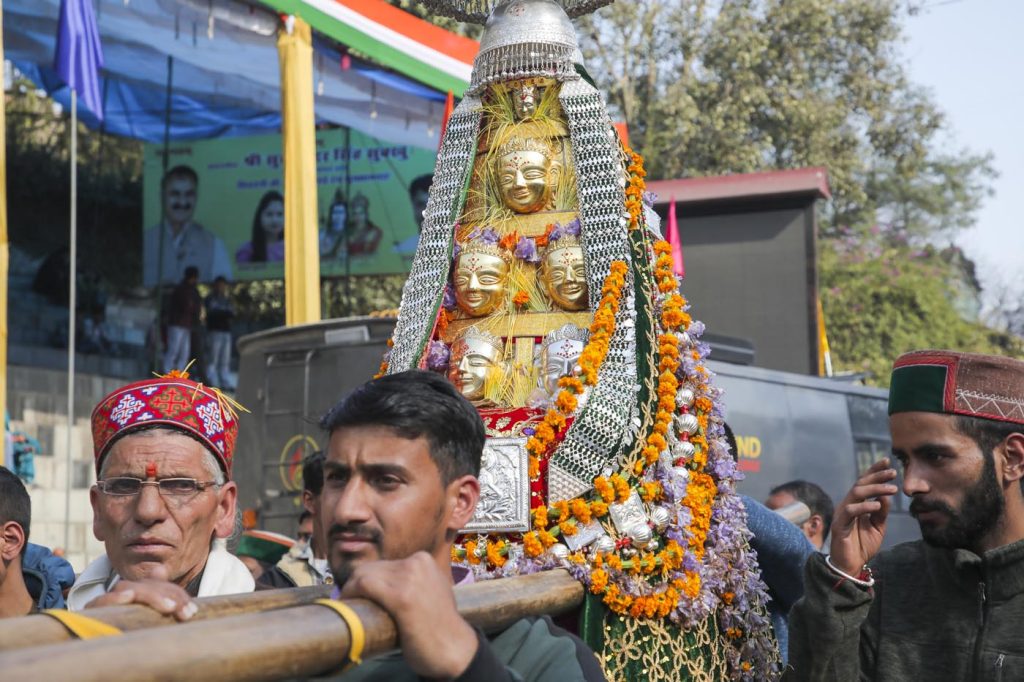
I arrive in Mandi on March 4, three days before the festivities begin, allowing me time to get a feel for this old town once ruled by kings. I meet a native journalist and photographer, Birbal Sharma, who explains how the people interact with the visiting Gods (Devatas) and Goddesses (Devis).
The Divinities are brought from Their home temples to Mandi, some far away, on ornate wood-frame palanquins usually carried by two men. Mounted in front are mohras, gold or silver masks of the Gods, the most prominent represent the main temple Deity, and have been consecrated in a pran prathishta ceremony to carry the power of that Deity. The function is similar to the parade Deity in a South Indian temple, which is taken out on special occasions, but otherwise kept inside the temple and regularly worshiped in a shrine. Here, the parade Deities are taken far outside Their local area to join with other such Deities in large numbers.
One must understand, I was told, that the hill people regard these Gods as living beings, able to talk with you, understand your problems and offer guidance. Communication is facilitated through the gur, a person who serves as a medium, directly conveying the words of the Deity.
Birbal Sharma further explained that the Gods also communicate with one another—apparently a consequence of so many convening in the same place at once. When two palanquins meet, each with its respective God, interaction between them may be evidenced by involuntary movement of the palanquins, which become difficult for their carriers to control. The gur for one Deity may speak to the gur of another. It is a hypnotic sight—mood, sentiment, even insistence is expressed. It may seem exotic to outsiders, but for the hill people, the Divinities are living inner-plane beings able to bless you with peace and prosperity and make prophesies for the future. People find solace in Their company.
A visit to Mandi is incomplete without walking through the rustic lanes and enjoying the small, sleepy bazaars, just a stone’s throw from the main road. Diminutive temples dot narrow lanes, and the air is filled with the aroma of spicy Himachali delicacies cooking in roadside restaurants and kiosks. The old part of Mandi has many historical temples.
History of the Fair
The tradition of celebrating Sivaratri in this way began during the reign of Raja Ajber Sen, who in 1527 built the Bhootnath (“Lord of Ghosts”) Siva temple. During Sen’s reign, Mahasivaratri was celebrated each year in the temple’s courtyard, with a several Deities coming in from other temples. Over a century later, Raja Suraj Sen, who ruled from 1664 to 1679, had no heir to the throne, as all his sons died, leaving him alone and totally dejected. His advisors suggested he give over the throne to God. Embracing the idea, the king built a temple for Madho Rai, a form of Vishnu, not far from Bhootnath and the royal palace. He engaged the goldsmith Bheema to make a silver murti of Madho Rai. That murti was declared the king of Mandi region and remains so regarded today. Bahu Sen, the King’s brother, carried on the lineage as the representative of the royal family. Today, his descendant Omeshwar Sen has a central ceremonial role in the festivities, greeting each visiting Deity personally after they visit the Madho Rai temple.
During the reign of Raja Ishwari Sen (1784–1826), the fair was linked to the Mahasivaratri festival. Ishwari Sen was held a prisoner of war for twelve years after losing a battle with the king of Punjab in 1792. He was freed during the Gurkha invasion of Kangra and Mandi states. Upon returning home, the people welcomed him with great enthusiasm on the day of Mahasivaratri festival, to which he invited all Deities from all parts of Mandi. Ever since then, the week-long fair of Mandi begins with Mahasivaratri. It is proudly stated that the mela, which started with the establishment of Bhootnath Vishnu Temple, became a harmonious blend of two religious traditions, Vaishnava and Saiva, after Madho Rai Deity became the supreme head of the state.
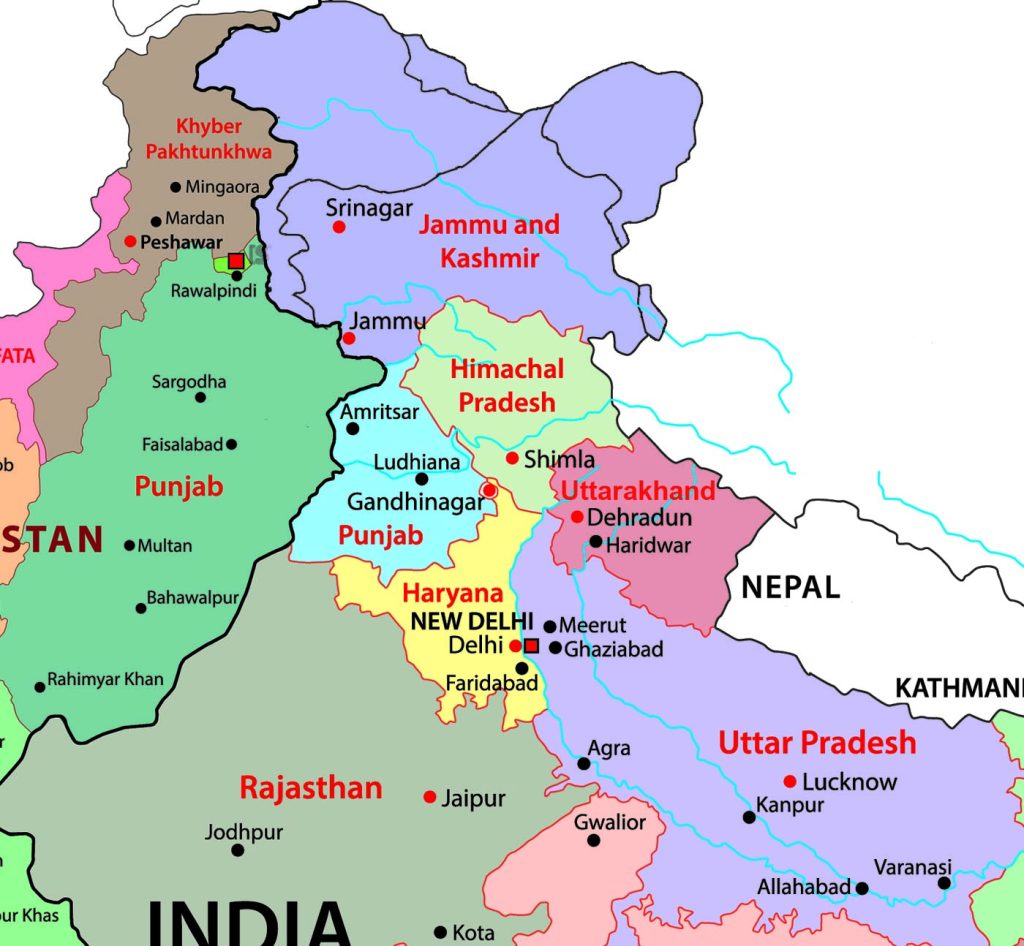
Similar festivals are held elsewhere in Himachal Pradesh, most notably the massive International Kullu Dussehra festival. Dating from the 17th century, it is celebrated in September/October, starting on Vijaya Dasami.
Kamrunag, God of Rain, First to Arrive
I was lucky to have located the party of Kamrunag—God of Rain and first to arrive in Mandi—at the house of Mohan Lal Saini on March 6 in Chandiyal, a picturesque village on the outskirts of Mandi. Saini and his family are deeply devoted to Kamrunag, the most respected of all the Gods and Goddesses attending the festival each year. His temple is in Bath Valley, about 37 miles from Mandi on the Kamrunag Lake at an altitude of 11,000 feet. The journey on foot along a traditional route takes about two weeks, with many stops along the way. Each year, Saini hosts the God, Who is represented by a large, heavy, ornate spearhead, greeting all those accompanying Him.
Kamrunag. Pandit Shiv Pal Sharma, head of the Committee of Devatas (as the Gods are locally called), receives Kamrunag in Pulgharat, the main point of entry to Mandi. The committee maintains a list of Deities to be invited from the more than 500 temples in Mandi District, keeping in mind the scarcity of space and the possibility of overcrowding. Sharma is responsible for each temple’s accommodations and care in Mandi. All the Deities and the accompanying musicians are paid honorariums by the government.
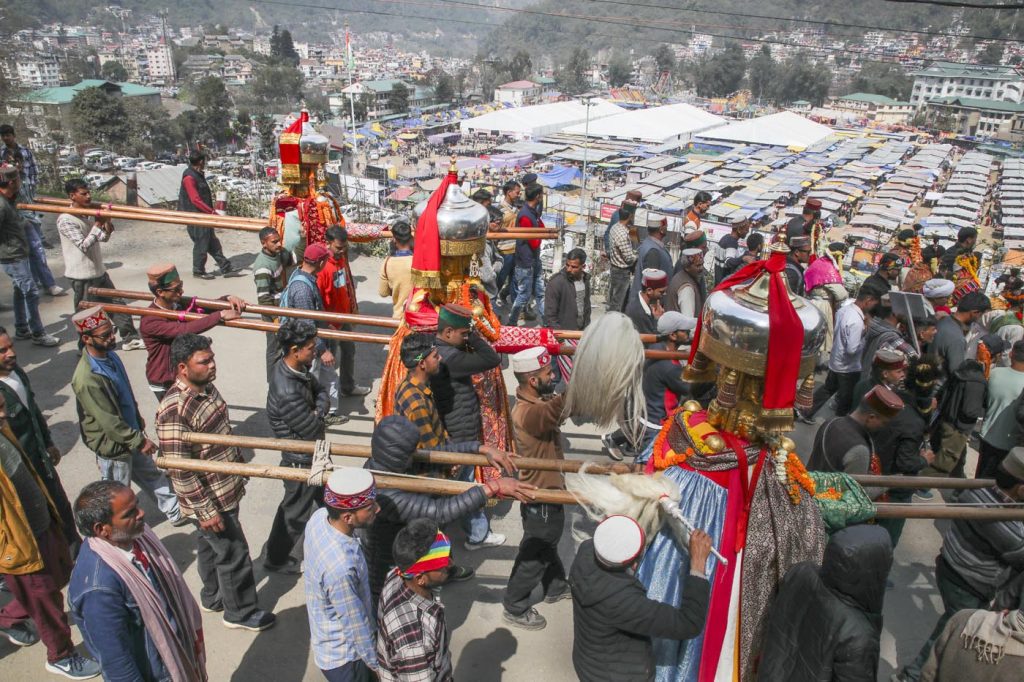
Instead of being carried on a palanquin with mohras (images of the Deity) and decorations, the Kamrunag spearhead, attached to a long silver pole, is carried by one of His devotees. The crowd swells as the procession reaches Madho Rai Temple. Deputy Commissioner Apporv Devgan welcomes Kamrunag before Kamrunag offers His prostrations to Madho Rai.
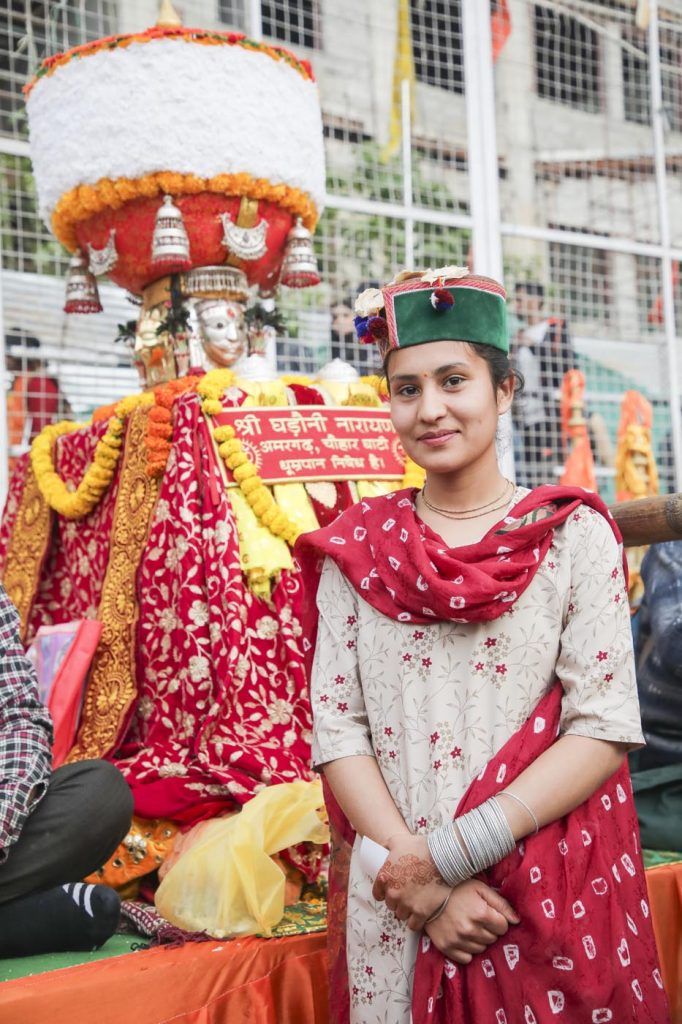
Devgan, one of the principal organizing officials, said the government has spent us$500,000 on the event this year alone. They organize volleyball, wrestling and cycling championships, theater performances, poetry recitation and painting competitions. Hundreds of traders come, adding tremendously to the local economy. “Our focus is to promote our language, art and culture,” Devgan declared.
Mahant Devendra shared, “Every person of Mandi is Godlike. It is a city of faith, of intense religious belief.” Rituals begin long before Mahasivaratri. Each day of the preceding month, from tara ratri (the ninth day of the waning moon in the month of Shukla) to Sivaratri, the Siva Lingam in Bhootnath Temple is covered with butter into which a representation of a different God is scribed. Women of the neighborhood bring homemade cow’s milk butter for the purpose. Artistic youngsters create each day’s image.

Mahasivaratri Day
Today, March 8, is Mahasivaratri, the day Lord Siva married Parvati, according to local tradition. It is perhaps the most important festival celebrated in Himachal Pradesh. Thousands celebrate by fasting, worshiping at a temple, offering Ganga water to the Sivalingam and more. Long queues brave the morning cold in Chauhatta Square, waiting to worship in Bhootnath Temple. The temple’s narrow alley is jam packed.
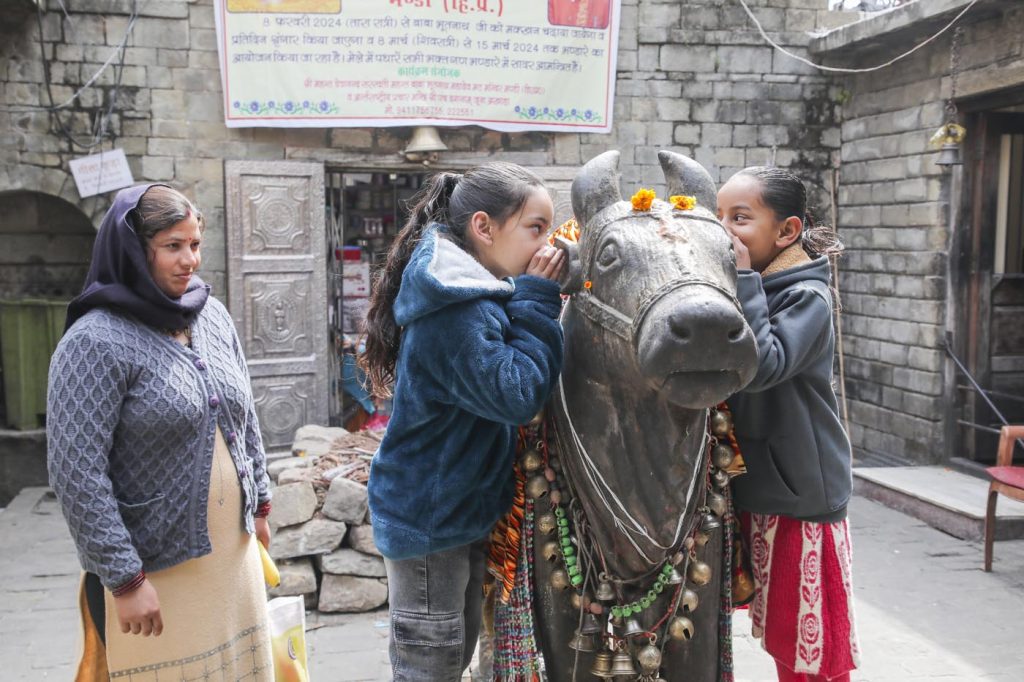
As devotees wait with their offerings of milk, bilva leaves and flowers, a symbolic marriage procession of Siva and Parvati makes its way past the square, headed by Mahant Devananda Saraswati, head priest of the Bhootnath Temple. Mahasivaratri is observed as a night of worship, bhajan and meditation, and thousands of ardent devotees keep the traditional all-night vigil in Bhootnath and other Siva temples in Mandi, such as Panchvaktra and Maha Mritunjay.
Sivaratri is the day the Gods and Goddesses reach Mandi. All roads leading to the town have caravans of bajantris (musicians), devlus (devotees) and the quintessential palanquin—locally called a rath, though a rath is normally a wheeled chariot pulled by hand. People welcome them with folded hands as they inch their way to the Madho Rai Temple. The melodious music of drum beats and trumpets resonates through the town. Some of the Deities have come from long distances, spending nights in the forests and villages. They have their fixed halting places. Each group coming into the town includes devotees, the gur and, in many cases, a police escort. Accompanying the musicians, with their drums and enormous horns, are people carrying chharis, beautifully decorated silver staffs with colorful cloths tied atop. A total of 216 Gods and Goddesses have been officially invited to the festival by the local administration this year. So far, 193 have arrived for the fair.
Let the Fair Begin
The International Sivaratri Fair officially began the morning of March 9, but there is a small procession (locally known as jaleb) to Bhootnath Temple on the 8th to seek Siva’s permission to start the festivities and inviting Him to join. A havan fire worship is performed in the courtyard of the Madho Rai Temple. As per tradition, only the palanquins of Shukradev Rishi, Jaidev Shri Jhati Veer and Dev Dhangaru participate. The Deities offer their obeisance to Madho Rai and then meet among Themselves. Mounted police lead the colorful procession, with bajantris playing their drums and loud trumpets just behind. Mandi’s deputy commissioner, Apporv Devgan, walks behind the procession with other officials. His family take darshan of Bhootnath, symbolically inviting the Deity to the festivities.
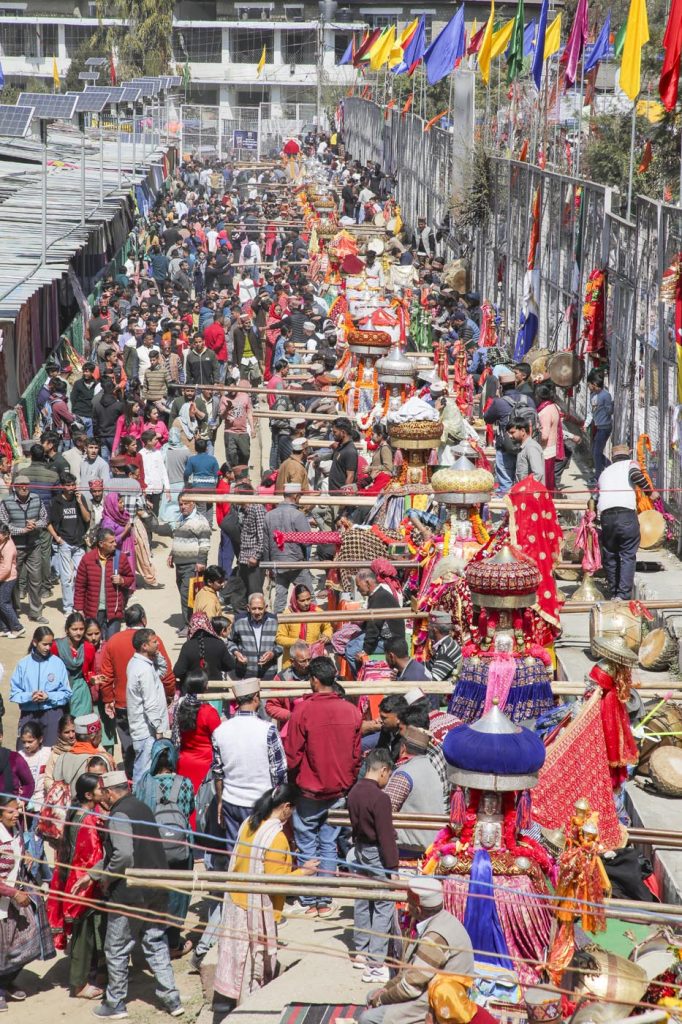
Three processions are organized during the week-long fair on the first (March 9), fourth and seventh days. Following the traditional system, only certain Gods and Goddesses take part in these processions. The others remain in their respective places of stay, spending the day in the festival grounds, a large field known locally as paddal. Herenearly all Deities are assembled in rows. A few of the Gods do not go to the festival grounds. Kamrunag, for example, remains in the Tarna Mata Temple for seven days, while Dev Shri Parashar Rishi and Budha Bingal reside in the Narol courtyard of the palace.
Today, March 9, the Siva Lingam has returned to its unadorned form after the abhishkam bath, and the temple has been opened to the long queues of devotees. A squad of young boys and girls, joined by IT professionals, teachers and doctors, offer their services for the daily chores at all temples in Mandi. The first procession begins on March 9—in the afternoon, giving people a chance to recover from the previous long night of Sivaratri festivities and worship. In the Chauhatta square adjacent to the Bhootnath Temple, passersby are attracted to three majestic palanquins of important Deities seated on the pavement: Magru Mahadev, Shri Hari Vishnu Narain, and Nag Chhaplandu. Late-arriving Gods continue to visit Madho Rai Temple.
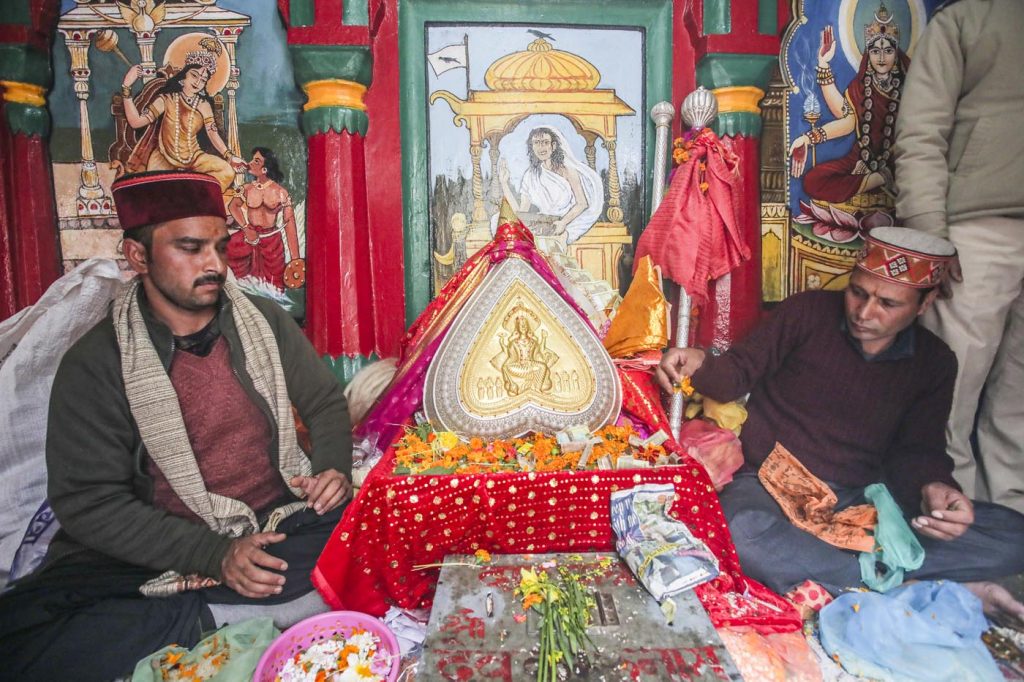
The Main Procession
Deities escorted by their musicians and devotees wait to take part in the procession to the festival grounds. Meanwhile, crowds swell gradually at Seri Manch, an open-air stage a few hundred feet from Madho Rai Temple and Chauhatta Square. There, turbans are being tied on the heads of honored members of society, including the chief minister of the state. In Himachal Pradesh, the turban is a part of the dress code for men at auspicious ceremonies, especially weddings.
One of the highlights today is the huge drum called tamak from the Tungal region, saved from extinction by the collective efforts of administrative and cultural agencies. Men and women dancers from Saraj valley, in traditional costumes and jewelry, dance with the procession. Faguli dancers are the center of attention, their faces masked with jute-like fibers and wearing loose wool outfits.
Amidst the thunder of drums and trumpets appear the magnificent palanquins of the Gods in an order followed since olden times. Only the foremost Divinities, totally 26, take part in the processions.
The Gods Dev Chhamahu Sheshnag and Dev Chhanjanu lead the procession. Close on their heels follow the Gods from Saraj valley: Markandeya Rishi, Dev Kotlu, and Vishnu Matloda. Behind them are Dev Shetty Nag and Devi Ambika. The trio of Magru Mahadev, Bayala Narayana and Nag Chhaplandu follow; then Vitthu Narayan, Luxmi Narayana and Ambika Nau. Next some the four quintessential Gods of Chauhar Valley: Pekhra Gahri, Dev Pashakot, Bada Dev Hurang Narayan and Dev Ghadauni Narayan. They are easily recognized by their unique palanquins. In the center of everything, the palanquin of Madho Rai marches past. A few more Gods bring up the rear, followed by the Chief Minister of the State, Sukhvinder Singh Sukkhu.
The procession culminates at the festival grounds. The chief minister then formally inaugurates the exhibitions set up here by government agencies, cooperative societies and self-help groups. Two other processions proceed along the same lines, with the same Deities but different dignitaries. The evening features popular singer Hansraj Raghuvanshi. The spell-bound audience sings Siva bhajans with him until late in the night. The huge stage at the Seri Manch is continuously occupied by artists. There are competitions for children and women in the morning. Evenings are cultural programs by visiting troupes.
The Festival Grounds
The entire area is a sight to behold. The riot of colors, the air redolent with myriad incenses, the soothing effect of the balmy Sun and the charged atmosphere are enough to send anyone into a trance. Every God and Goddess has a designated place to settle in a particular order. The amount of space given to a Deity depends on His or Her rank and status. There is a distinct appearance of the Deities from each region, in the size and nature of palanquins, and their gold and silver masks or mohras.
Hundreds of thousands of people throng the grounds over the festival’s nine days. Nearly everyone, young and old, including children and university students, spares time each day of the celebrations to bow down in front of the divine figures, one by one, and make offerings large or small. Some devotees can be seen consulting the priests and gurs, seeking solutions to their problems. It is heartening to see little children following in the footsteps of their parents, with a promise to carry on the beautiful traditions to the next generation.
At the stall of Pundrik Rishi from Panjai, a group of men in traditional costumes are dancing as bajantaris play ecstatically. Some dancers perform with swords, the symbolic arms of the Deity which are proudly carried along with the palanquin. According to Promil Guleria, the district Language Officer, Falguli dancers and the masked dancers of Seraj Valley are star attractions of the jaleb procession. “To keep the tradition alive, we invite them especially on the occasion of Mahasivaratri Fair.”
Related Venues
There are other key places besides the festival grounds, Bhootnath Temple and Madho Rai Temple. One is the Tarna Mata Temple on a small hillock overlooking the town. Kamrunag sits here in the rear corridor of the temple. Tarna Mata is Goddess Shyamakali. She is so powerful that no one dares to face Her directly. Inside the sanctum, Her murti faces to the left, so devotees see Her from one side. The atmosphere is especially charged where Kamrunag is placed. The priest and volunteers attending Kamrunag are busy, tying the roli red thread on the wrists of the devotees, giving them rice grain as prasad and blessing them.
Another key place is the courtyard of the palace, where the six Devis (Goddesses) of Narol are staying. As told by one volunteer, in olden days, the king of Mandi would go to the fair alone, leaving the queen at the palace. Feeling lonely and slighted, the queen requested these six visiting Devis to remain in the Narol courtyard after being welcomed to Mandi. To this day, the six Devis remain inside the palace for the festival. Devotees come by the thousands to pay obeisance to Them.
This year, only four of the six attended—Baglamukhi, Budhi Bhairava, Kashmiri and Busain Baglamukhi. Apart from the Devis, the large room also hosts the famous Deities Parashar Rishi and Budha Bingal.
Meeting the Devotees
I encountered Sonam Thakur at the festival grounds. She was visiting every God and Goddess, one by one. “I have reached this far in two days, with five more days to finish taking darshan of all the Gods. I am here for mental peace. For achievements, you have to work hard and then it comes true with blessings of all the Deities here.” Sonam is keen on becoming an army officer. She failed in her first attempt and became depressed. “As I prayed to Them, ‘Please be with me,’ I could feel Their presence as a constant unknown force around me. Then came the moment, I found myself out of that traumatic time of my life. I did my postgraduate degree in English literature with the Gods being my guiding force.”
Shubhanya Thakur and her two friends from nearby Sundarnagar are here for two reasons—first, the darshan of the Gods and, second, shopping and enjoying the festival. For friend Sukanya, the charged atmosphere with the presence of such a gathering of divine figures and the music of drums and trumpets is very special. “You can almost feel the Divine around you! This is an entirely different feeling here, so divine amidst the mundane. The moment you are here, you find yourself at a different level of consciousness.” She was told by her parents to pay visits to all the Deities, especially Tarna Mata and Kamrunag.
Shubhanya personally requests the Gods to bless the whole of mankind with peace and prosperity. “From Kamrunag, I had wished at an earlier festival for my admission in a government college. With His blessings, I am now pursuing my engineering degree from Jawahar Lal Nehru Engineering College in our town. Shubhanya’s second friend, whose name I did not catch, is a staunch follower of Hateshwari Mata. She remembers how her wish of getting admission in the government engineering college was fulfilled last year. This year she is busy thanking the Gods by visiting each of Them.
Babloo Soni is enjoying the exhibitions with his wife, children and his sister’s family. Their purpose of coming was dual, to take darshan of all the Deities and take the children around to pamper them. “If we casually make a wish, it will never be fulfilled. You have to wish for something with complete faith, and then only the wish comes true,” he said. All his wishes have come true so far.
The Festival Concludes
In the early morning of the last day is the Chauhatta ki Jatar—“journey to Chauhatta.” Instead of going to the festival grounds today, all the Deities gather in and around Chauhatta Square, facilitating darshan to their devotees. Prophecies are made by Deities through the gurs. Rituals are performed to cast off evil spirits. The Deity Adi Brahma takes a round of the town to protect everyone with His divine power. The accompanying devotees tie a raksha thread on wrists for the safety and well-being of everyone.
Badadev Kamrunag comes down and bids farewell to Tarna Mata Temple. But before leaving the town, the Deity comes to Seri Manch, where devotees bid farewell to Him and seek His blessings. With heavy heart, the devoted inhabitants of Mandi bid farewell to the Deities, some of Whom visit Their devotees’ homes before leaving town.
Many more religious and cultural festivals of India need to be promoted on the lines of Mandi International Sivaratri Fair to keep us rooted for the sake of posterity. With a little effort and initiative from the people and the government, we should be able to conserve our rich cultural heritage and showcase it to the outside world. ∏π
Meet the Prominent Gods
Bhagwan Anant Balunag last came to the Mandi Mahasivaratri festival 144 years ago. He is regarded as an avatar of Lakshma and His temple is in a remote region bordering Kullu and Mandi. His arrival this year was the talk of the town. With no knowledge of the route they had followed more than a century ago, the party marched forward, led by the Devata himself, devotees behind him camping wherever the God directed a halt.
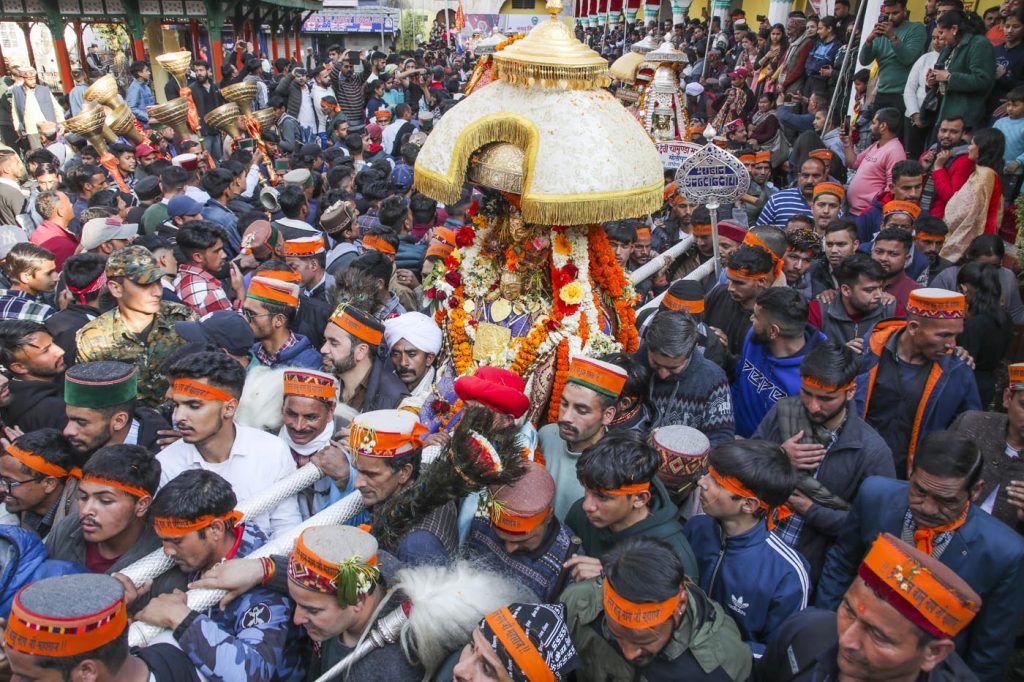
“The Devata had been expressing His desire to come to Mandi since last few years,” Balbir Thakur told me. “We were a little reluctant as we never came to Mandi after 1880. We have been able to convince the Devata about the situation during the last five years, but this time He was adamant and said, ‘Whatever you do, I have to go.’ ”
Khuddijahal of Dehuri, like Anant Balunag, is in Mandi after more than a century’s absence, at the insistence of the God. Traffic came to a halt when the Deity’s large procession of musicians, dancers and devotees reached Mandi. His palanquin was accommodated in Ekadash Rudra temple, next to the historical Victoria bridge. It travels to the festival grounds daily, though not as part of the main jaleb procession. As with Anant Balunag, His absence had to do with changes in district boundaries.

Khuddijahal is the richest of all Devatas. During the 1962 war with China, Khuddijahal and many other Deities gave gold to the government, which was returned after many years. Khuddijahal owns orchards, land and other properties. He has given land for 70 schools, 35 post offices, and other public utility facilities.
Shri Dev Markandeya Rishi from Aut is staying in Naina Mata Mandir in the village of Khaliyar, about three miles from the town. I was invited to Khaliyar by some boys carrying His rath. The entire neighborhood gathers in the temple to greet the visiting Deity. I asked Bhagat Ram Thakur about the God’s prophesies. He narrated the story of last year’s floods. When people requested the Devata to send rains, He replied, ‘You talk of rains? It will be difficult to save mankind.’ Many ignorant people could not interpret what the Devata meant by saying this. We had unprecedented rains and landslides in the entire Beas valley.”

Hurang Narain is the prominent God of Chauhar valley. His Rath is much different from others, with its dome covered with cuttings of white cotton fabric. He is known to bless people with children.
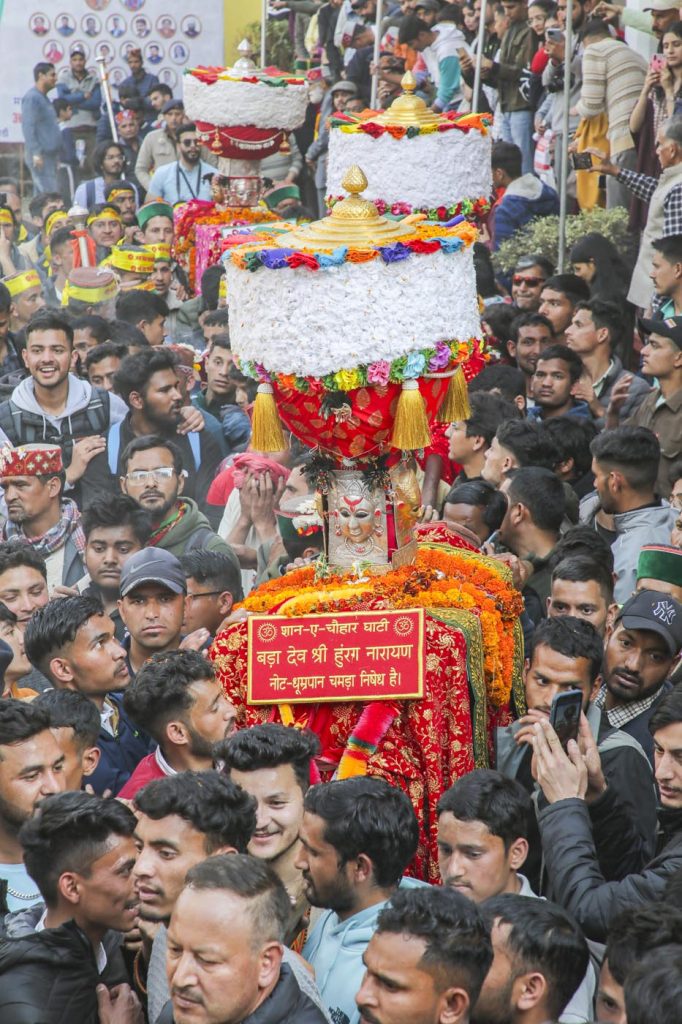
Balakameshwar Banyuri: Dev Balakameshwar is the Devata of lovers. A boy and girl who cannot marry because their horoscopes do not match go the temple of Bala Kameshwar, fifteen miles from Mandi. Marriages are solemnized there without astrological compatability. It is said the success rate of such weddings is one hundred percent.
Shri Dev Parashar Rishi, the father of Maharishi Veda Vyaasa, is one of the most important Deities of the area. But instead of taking part in the festivities, He stays in Rupeshwari temple, where the six Narol Devis also stay. Instead of having a rath for Himself, Parashar Rishi travels in the form of a chhadi, a long silver staff.
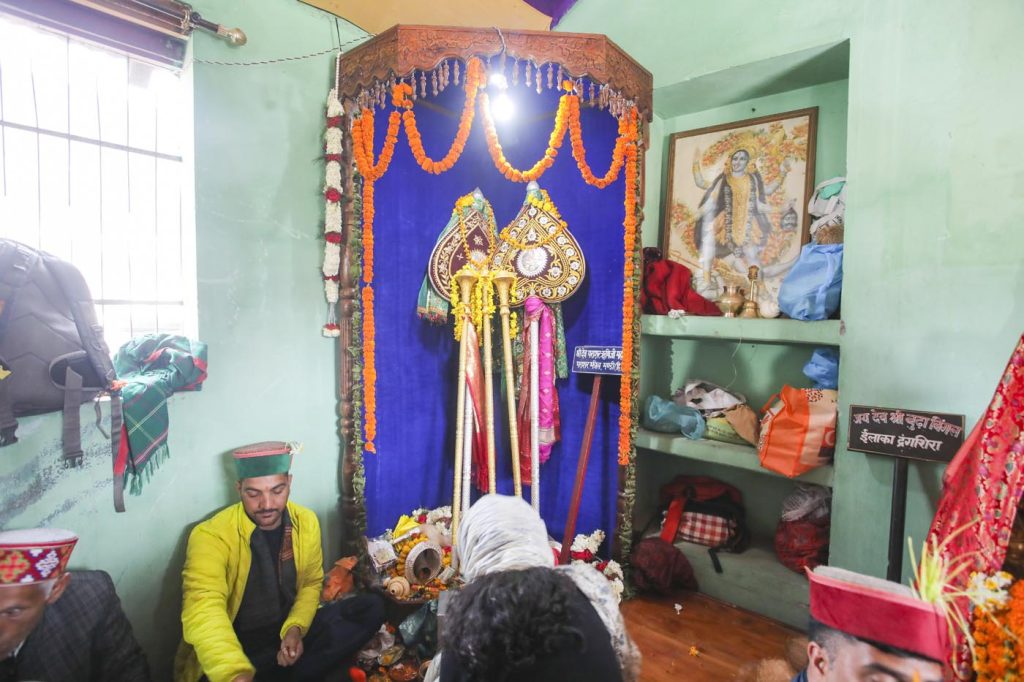
The native place of Magru Mahadev is Chhatri, about 75 miles from Mandi. The main mohra of the Deity was found in a field in Shwan village. His temple is one of the finest examples of the Kath Kuni style of architecture. It is said to have been built from a single cedar tree, with the craftsman being personally helped by the Devata, Who is known for His generosity.
Dev Vishnu Matloda is the most important Devata of the Saraj Valley. Situated at a height of 9,000 feet, His temple is 55 miles from Mandi. If a childless woman comes there seeking blessings, she is certainly blessed with a baby. Vishnu Matloda, one of the richest Gods, is a star attraction at the fair. His rath alone is valued at half a million US dollars, His gold necklace weighs two kilos, and He has land in many villages.
Maa Baglamukhi: Fifteen miles from Mandi, in Bakhli village, is the temple of the powerful Maa Baglamukhi. It replaced the original which was submerged in the waters of Pandoh Dam. She is one of six Goddesses who remain in seclusion during the festival. Baglamukhi is worshiped specifically for vaksiddhi, “perfection of speech,” such as in the arts of oration, debate and discussion. ∏π

Divine Palanquins

Speaking for the Deity
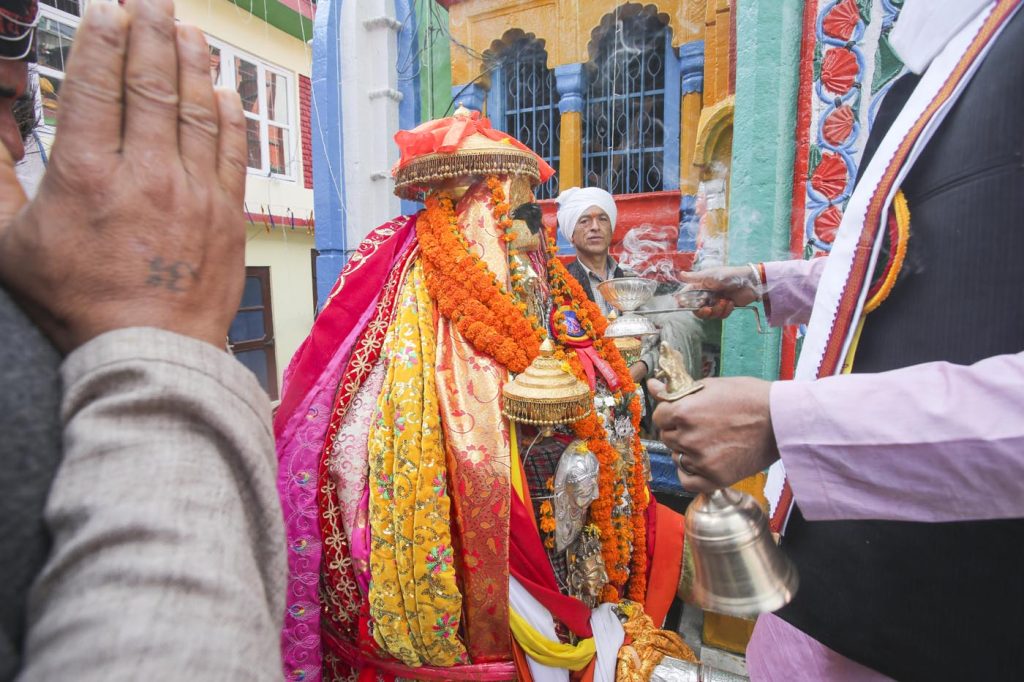
The most important component of the Devata system of religious practice is the gur. The gur is not a priest but a person who speaks on behalf of the Devata. The Devata is regarded as a living being, with pran and vani—life and voice. The gur remains in constant touch with the Devata through dreams and thoughts. There is a mysterious and unquestioned connection between the two.
Easily identified among the mass of devotees by his white turban, the gur usually remains silent when not speaking as the Devata. When he does speak, every single word is patiently listened to by devotees and village folk. At Mandi there were gatherings (photo lower left) in which the wise men of a village held discussions with the Deities through the gur, working hard to understand the right meaning.
Tall and lanky, Chaman Lal Sharma is the gur of Khuddijal Maharaj of Dehuri. He is from a family of gurs among which no one had been a gur for 18 generations. “One night, I was woken up by the Devata at 11:30. I almost lost my reason, unable to know what happened to me,” recounts Chaman Lal. “It was a call from the Devata to become His gur.”
In the dead of night, Chaman Lal left home, running madly on jungle roads. He went from one temple to another, drawing inspiration and gathering the power required for the job. He remembers, “My actions were following some unknown command. My body and mind were fueled with a strange energy, I could feel something happening inside me.” After a lot of rituals and pujas in the presence of many hundreds of people, Chaman Lal was initiated as the gur of Khuddijal Maharaj.
Although they lead a family life, gurs are very disciplined. It is not their duty to perform rituals in the temple, yet they have to be there nearly all the time. On the advice of the Deity, they convey prophecies and prescribe rituals and remedial practices to the followers to overpower the ill effects of evil spirits on people.
The diversity of palanquins is not limited to their varied colors and shapes. Every valley has its own style. Locally called a rath, each has several mohras, bas-relief images of Deity faces in metal. The main Deity face is made of an alloy of eight metals, ashtadhatu, while the others, depicting the same or related Deities, can be of any other metal, including gold or silver.
The rath’s purpose it to allow the Deity to be taken out of the temple. Before so used, the pran pratishta consecration is done for it. “This give the mohras the same divine power as the image in the temple. Taking darshan of a moving Deity is as beneficial as the darshan of the Devata in the temple,” states Bhagat Ram Thakur, from the party of Markandeya Rishi.
The tops of the rath, called the mandap, differ from one region to the other. Some are made of silver, while others are of made of beautifully embroidered velvet, or even cuttings of white cotton cloth. The raths are decorated with artifacts, such as crowns and pieces of jewelry donated by devotees, including the royal family. Each rath is carried on two long wood poles, are often encased in silver. These are strong but flexible, so they can bend freely during the dancing.
Usually, two men carry the rath on their shoulders. They have to be strong enough to bear the weight, as well as any sudden twists, turns and sideways bends caused by the Deity. This phenomenon can be seen in videos of the event. When the carriers do not understand what the Deity intends by some movement of the palanquin, the gur is nearby to explain.
Two Hundred Gods and Goddesses Arrive to a Kingly and Sacred Welcome
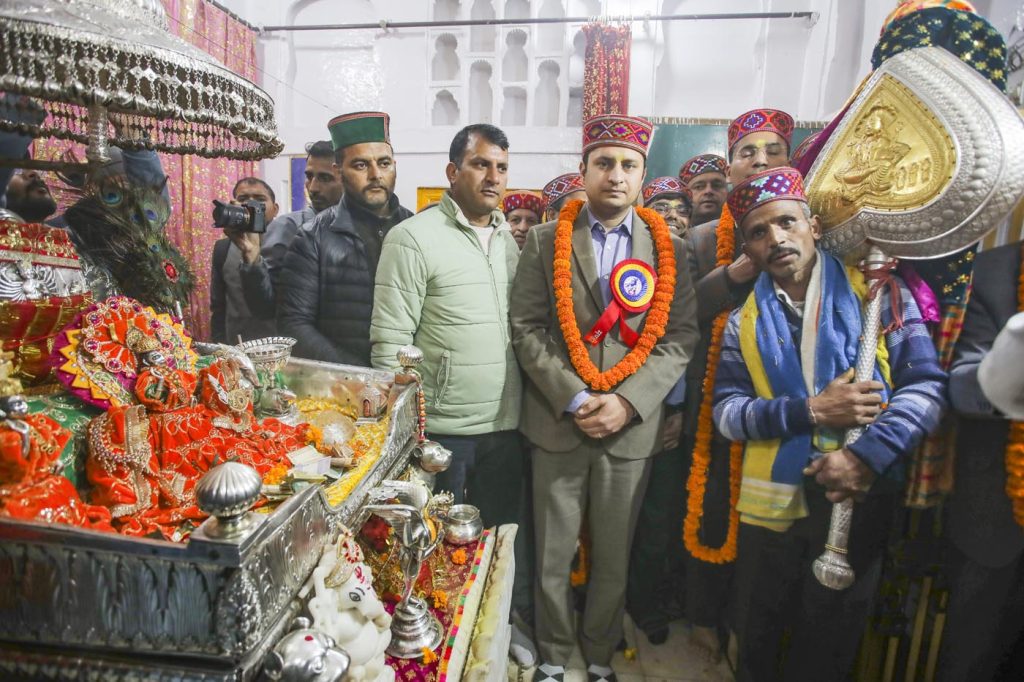
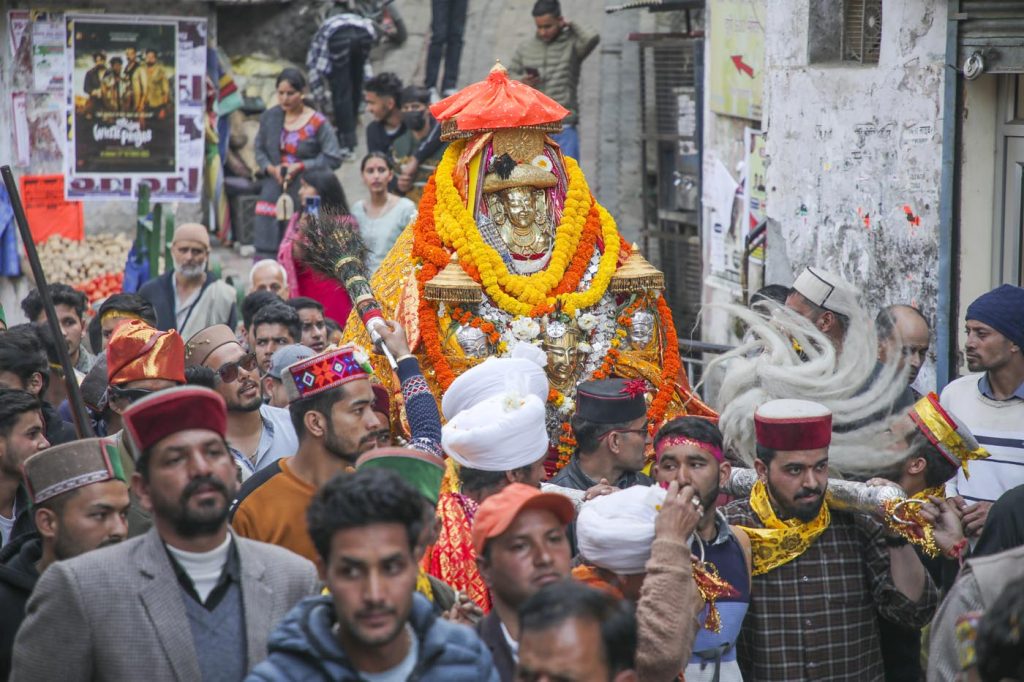
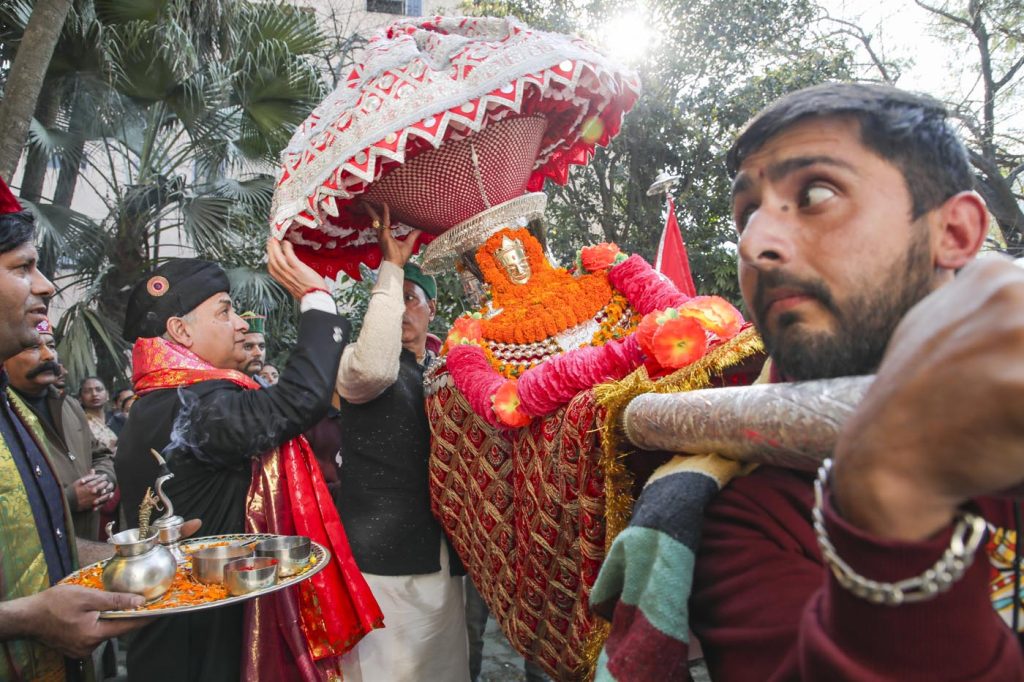
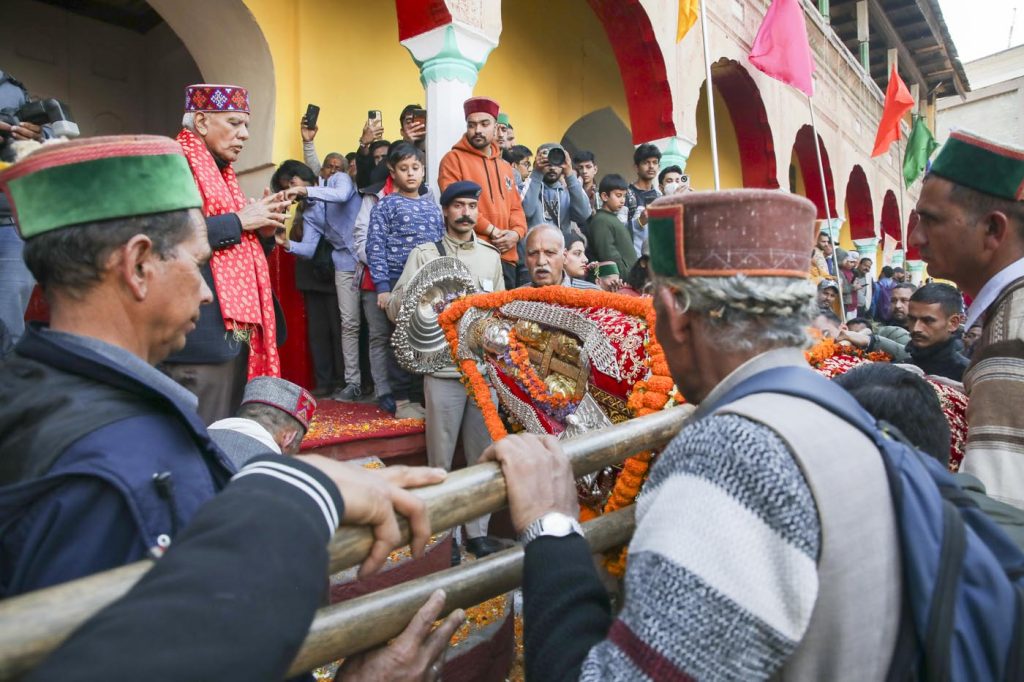
Pomp and Ceremony
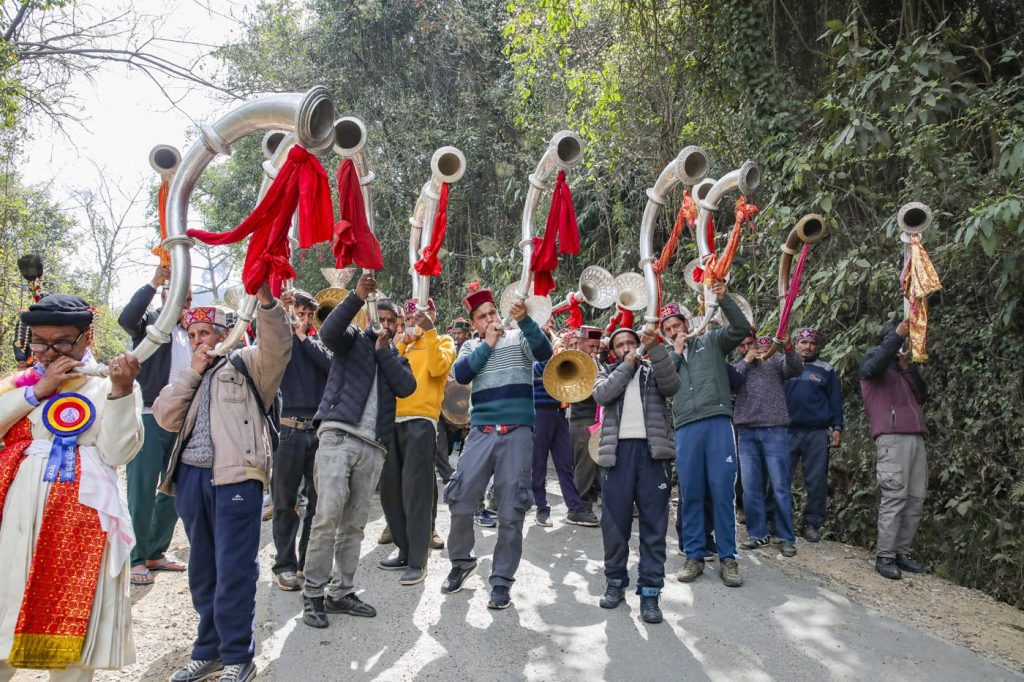
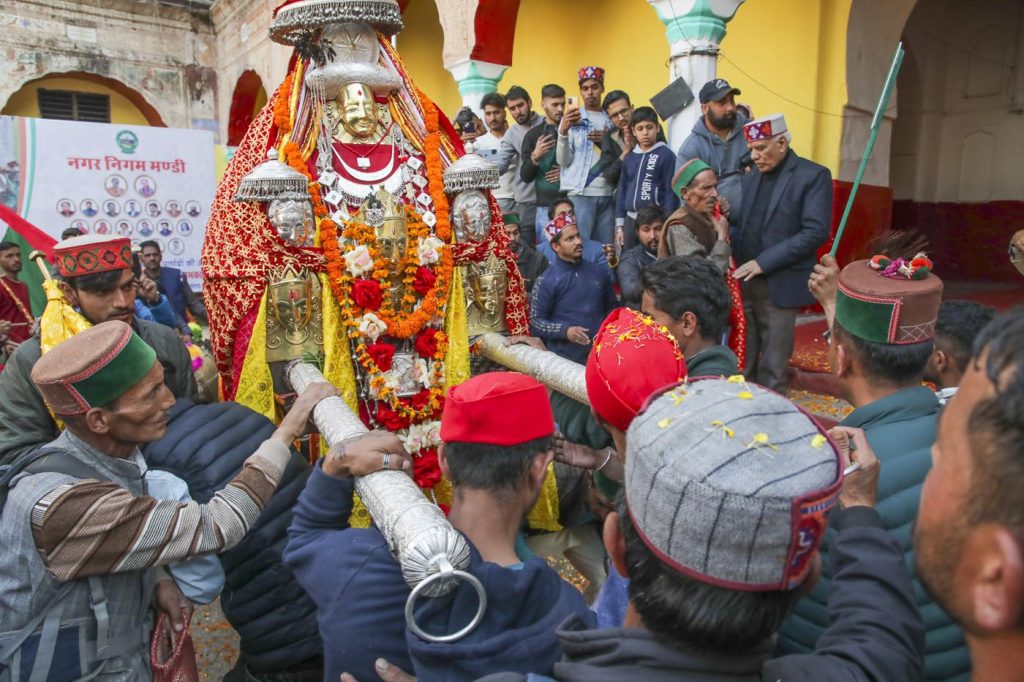

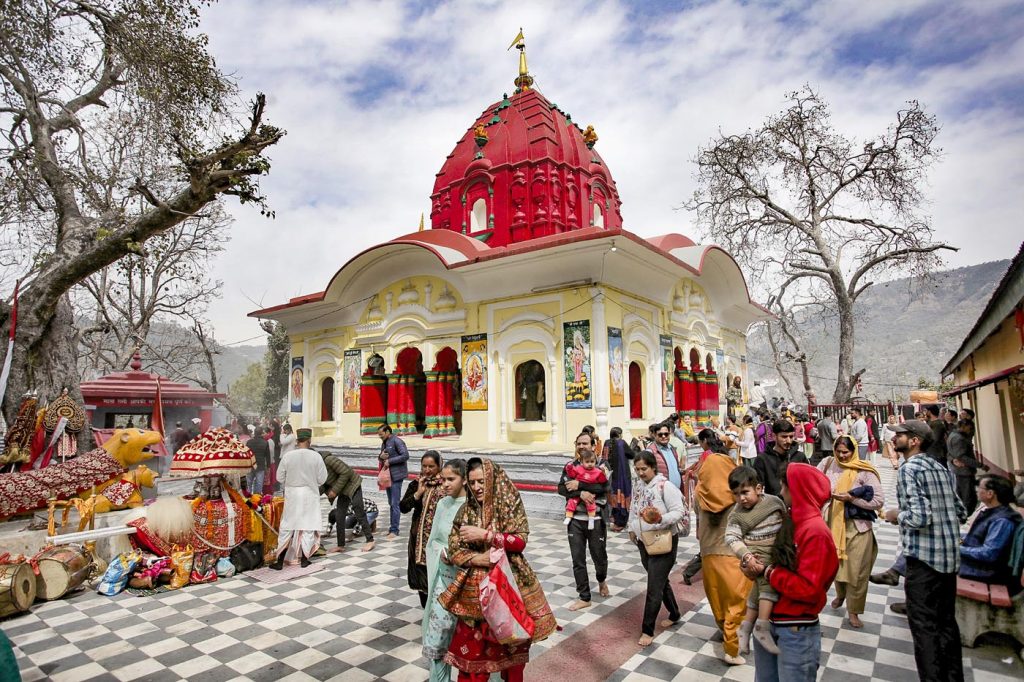
Music and Dance Are Major Parts of the Event
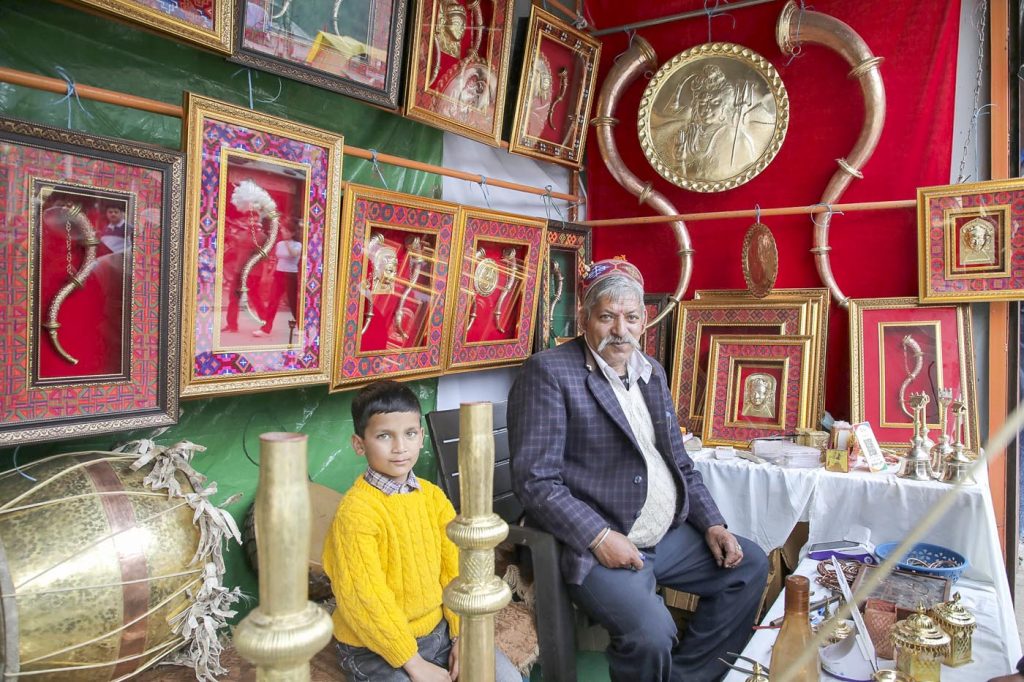
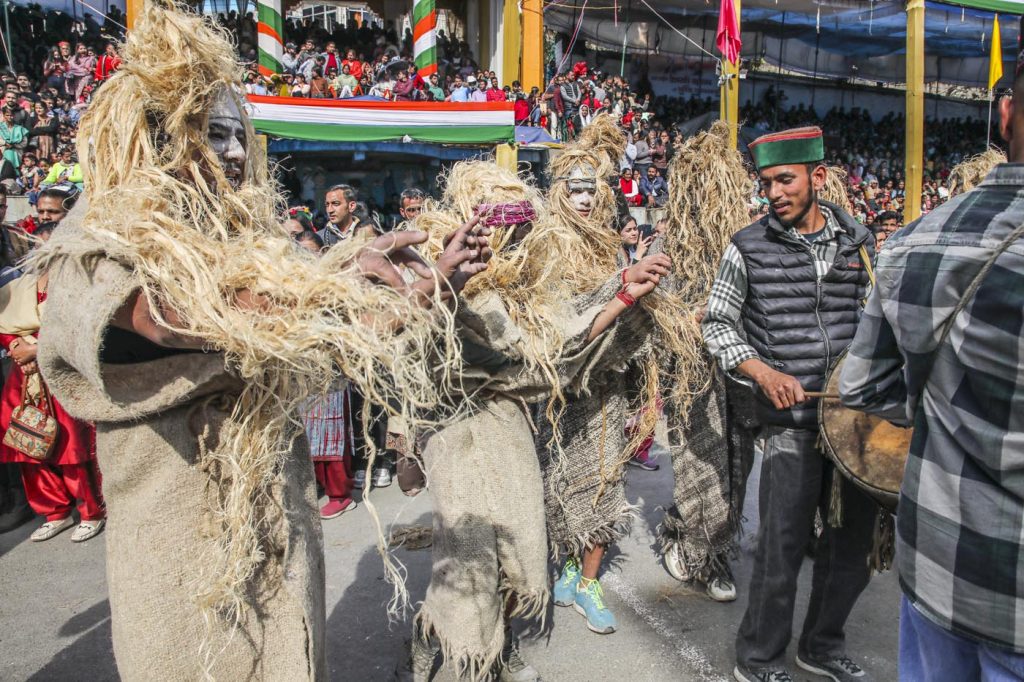
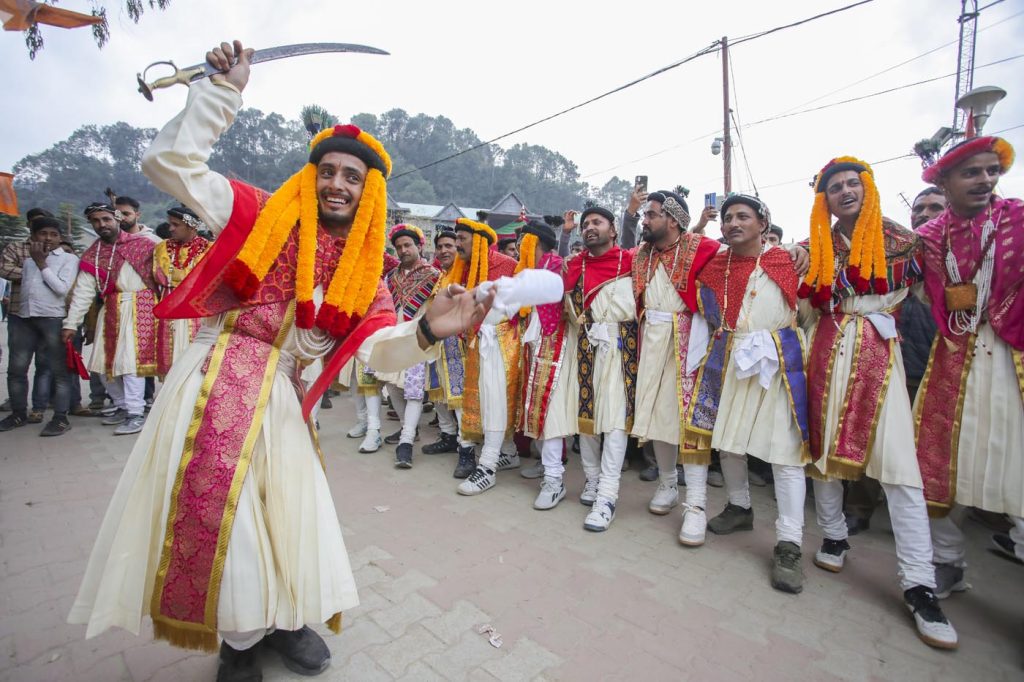
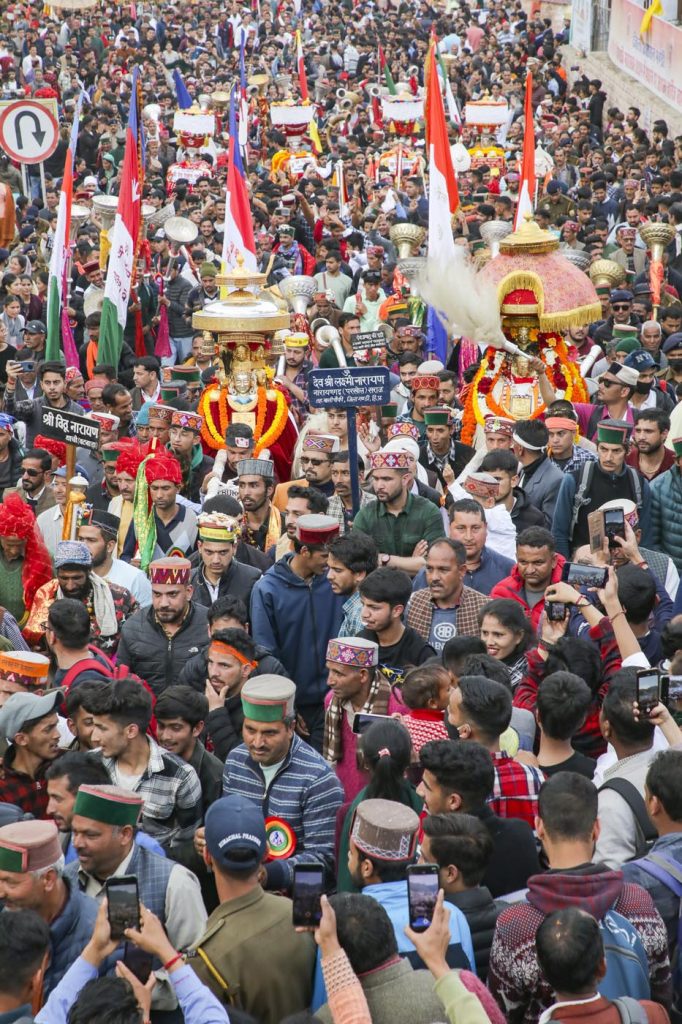
Festival Scenes

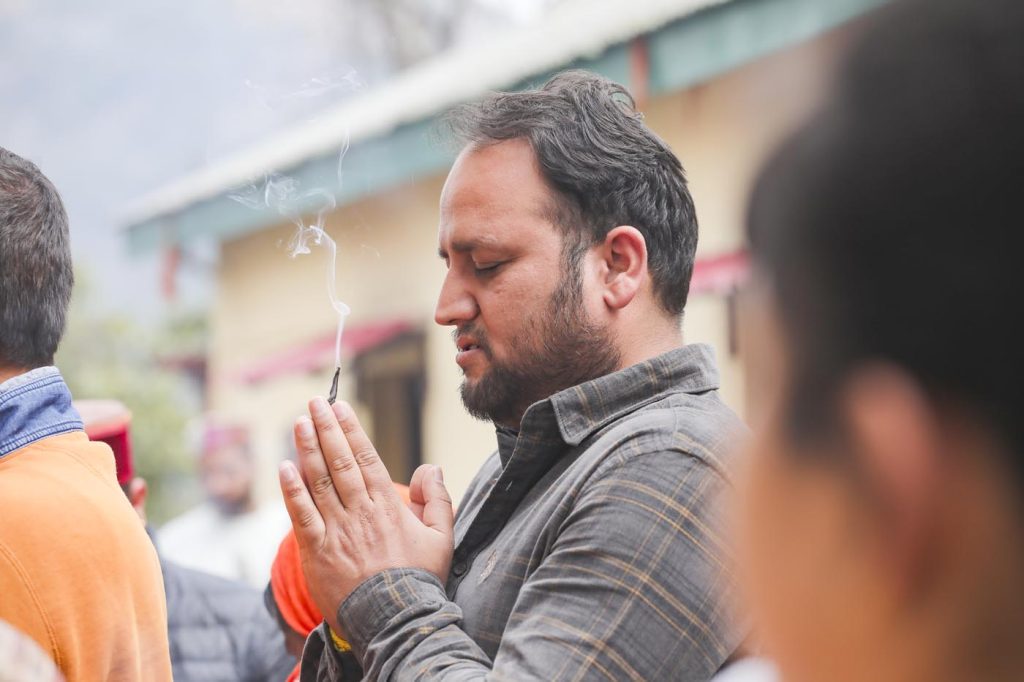
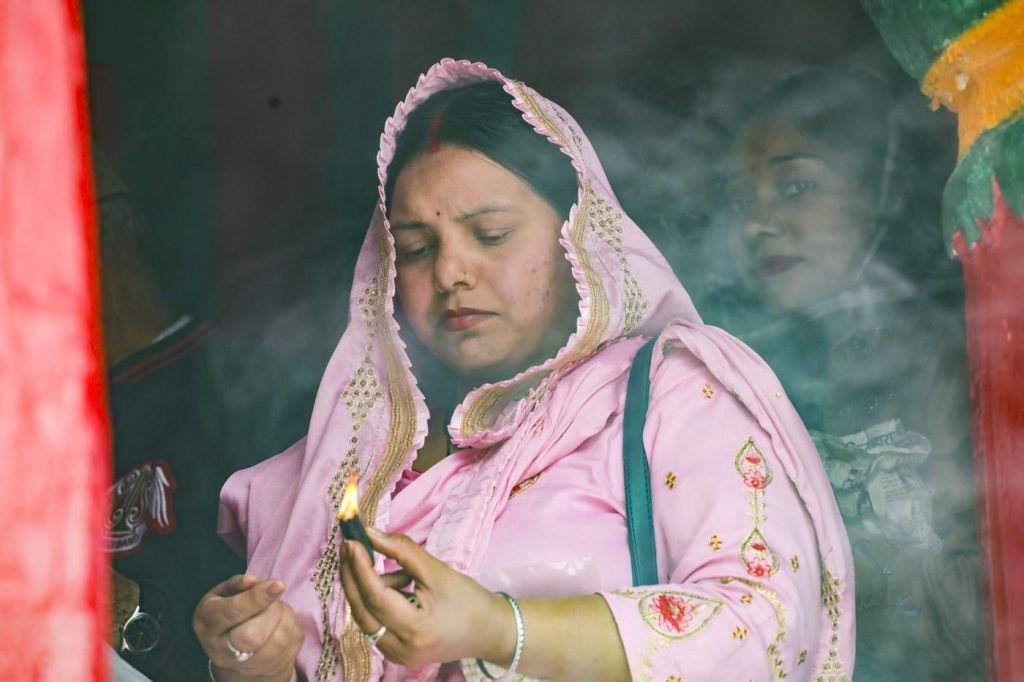
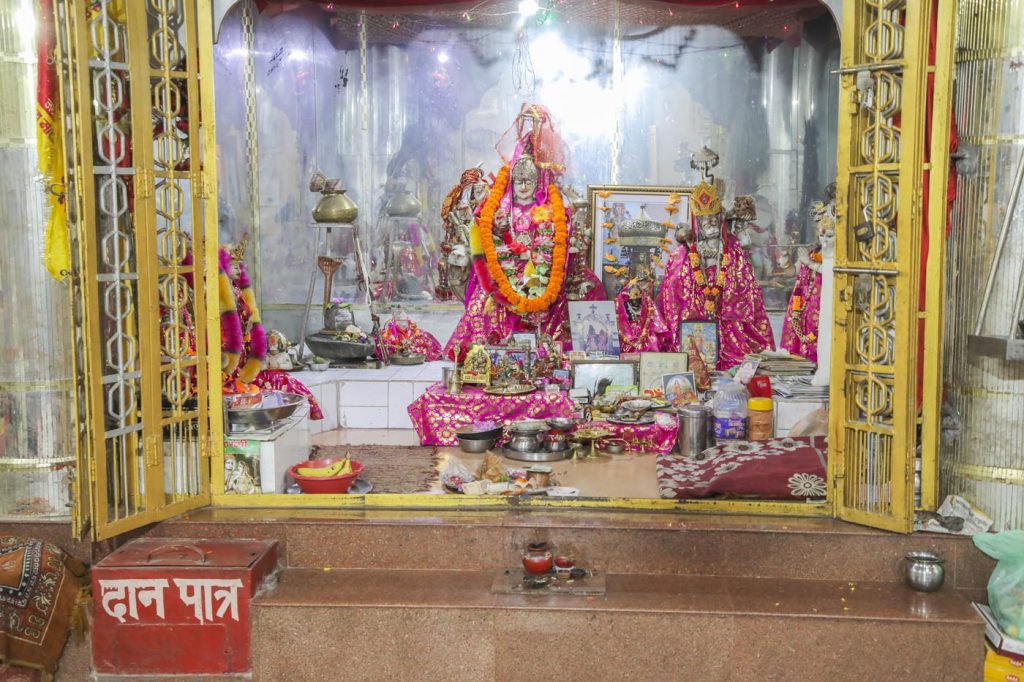
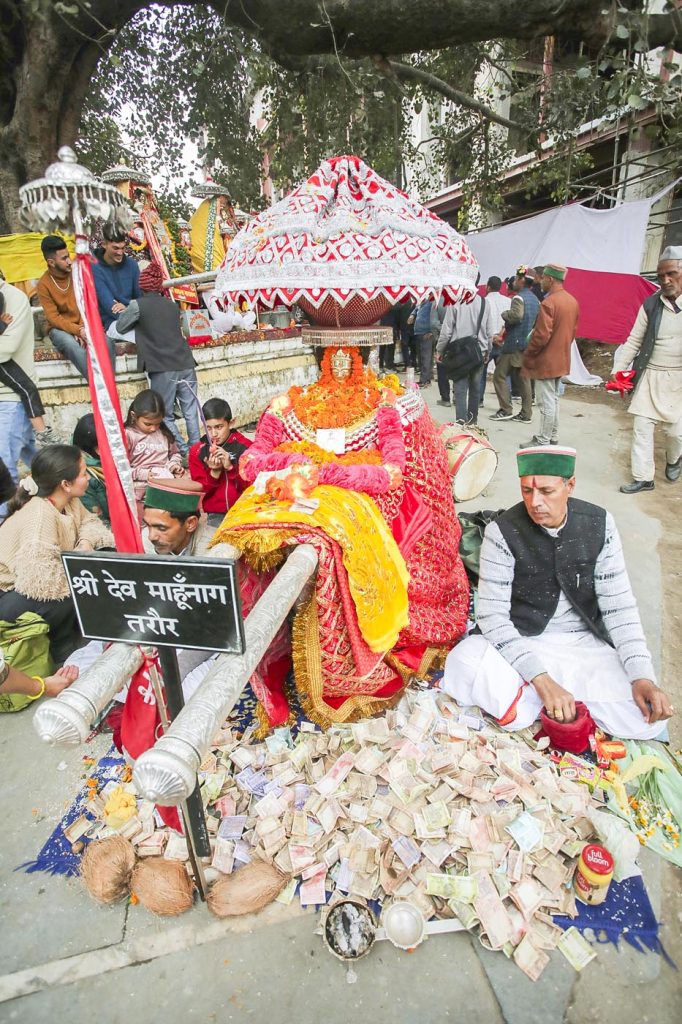
Mandi’s Magnificent Himalayan Setting
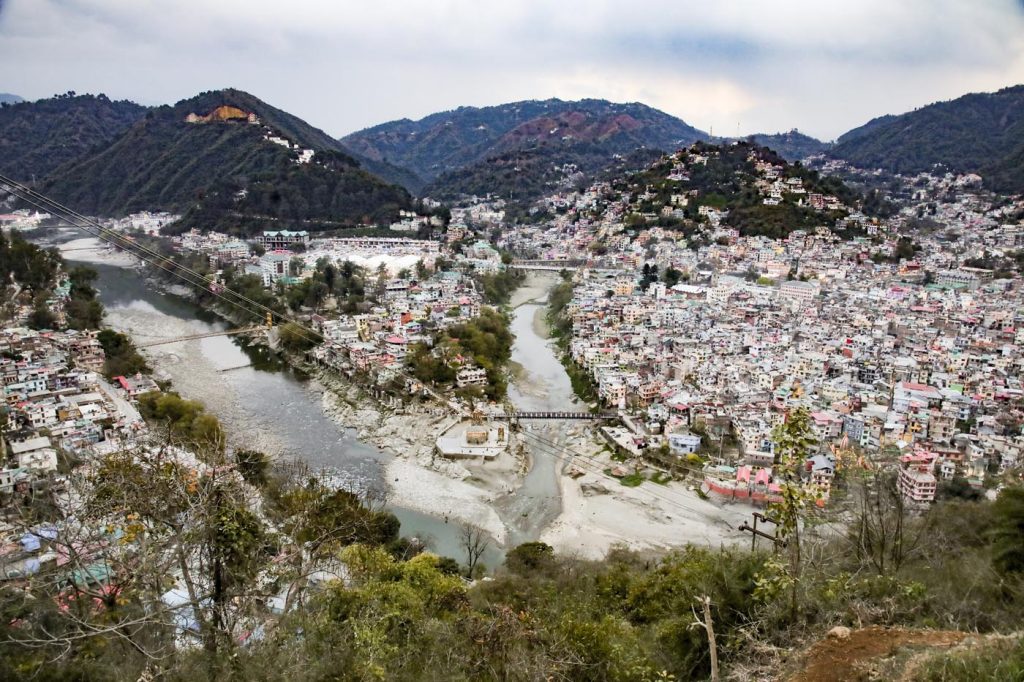
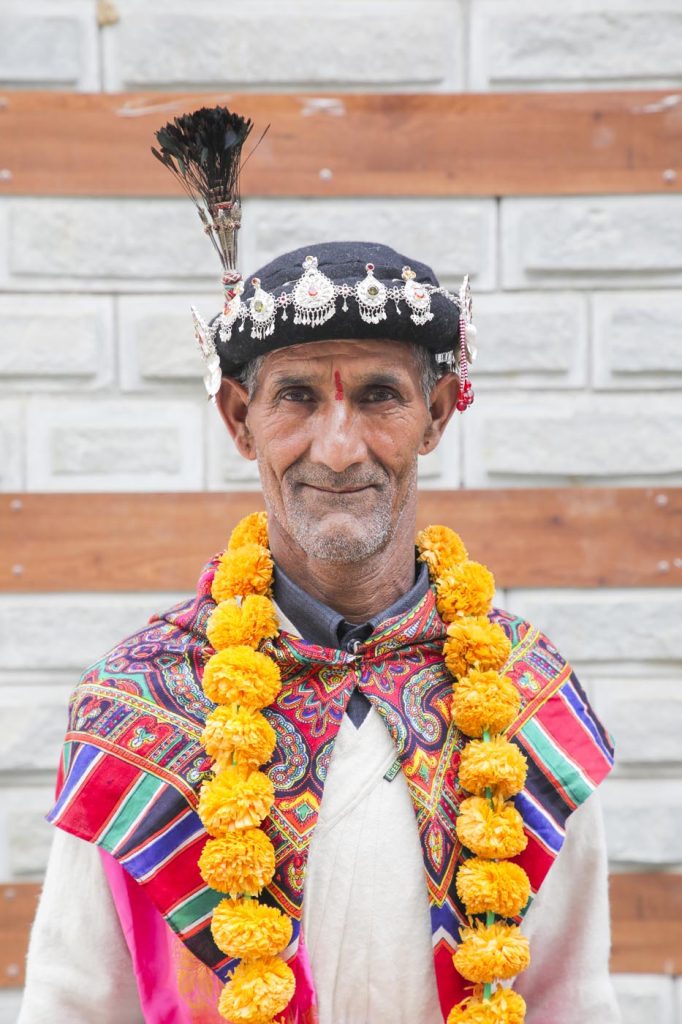
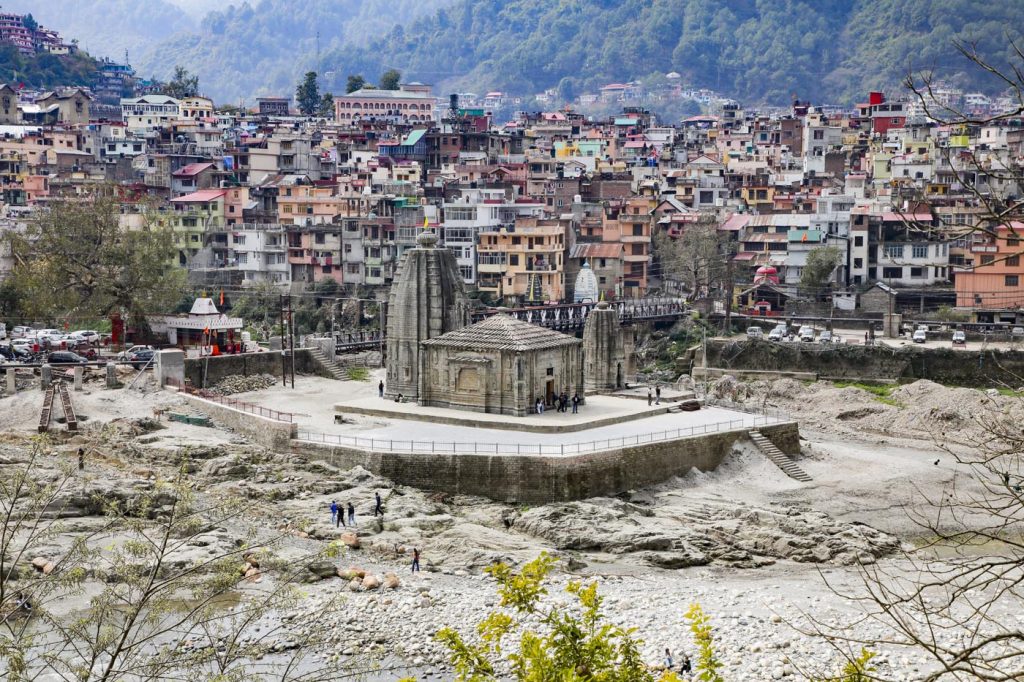
About the Author
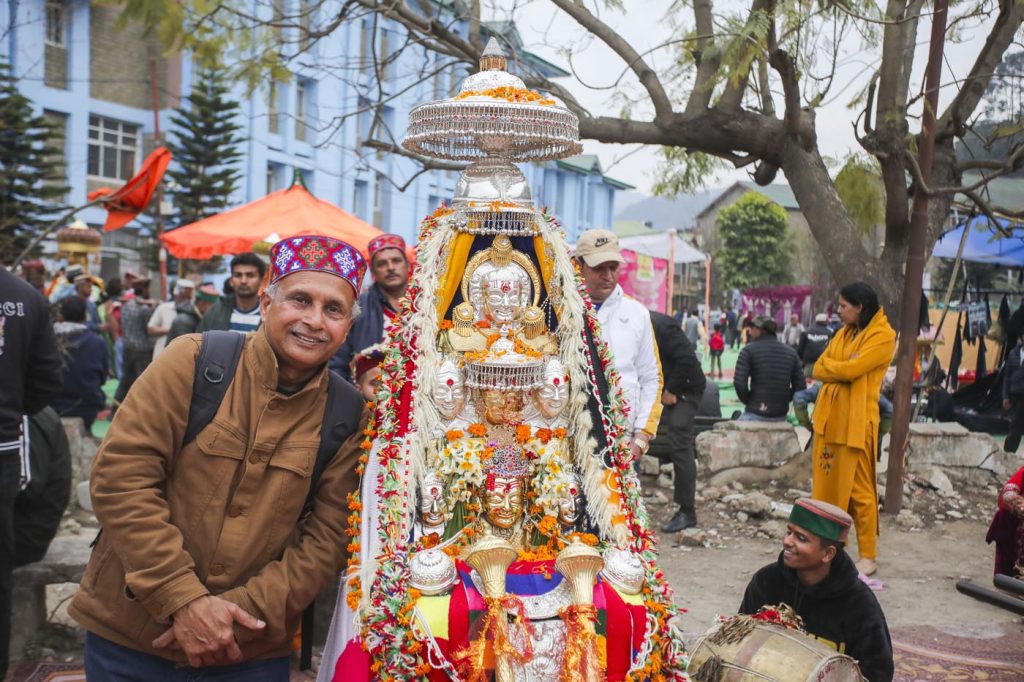
Dev Raj Agarwal of Dehradun, India, is a photographer who loves to capture Bharat’s immense diversity of people, cultures and nature, especially in the Himalayas. Email: devrajagarwal44@gmail.com
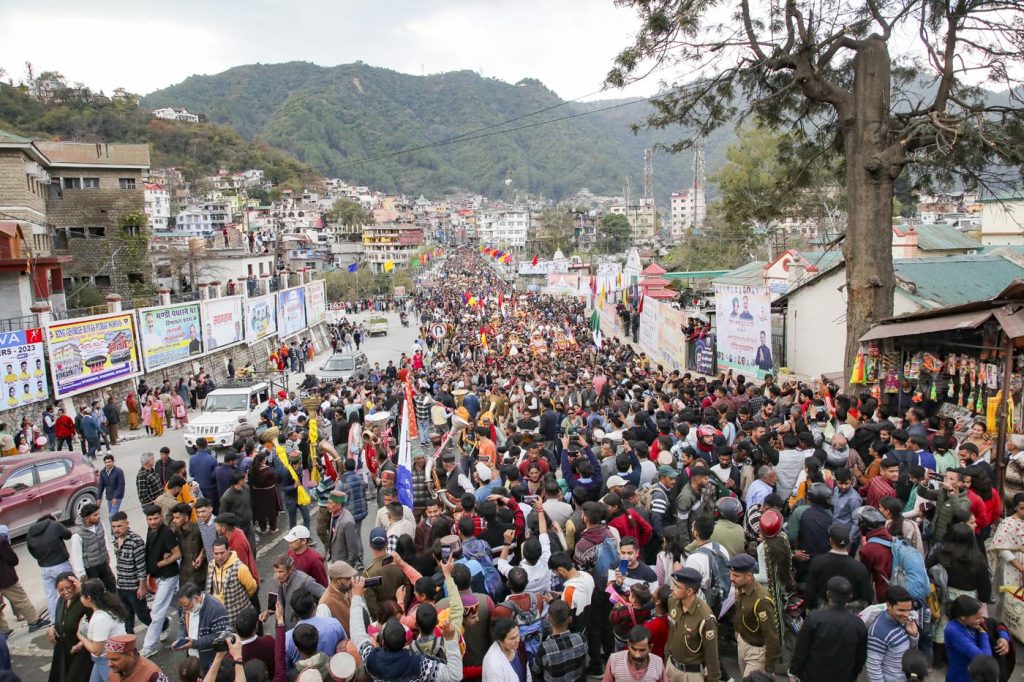
What an extraordinary article about this amazing international Sivaratri festival unknown in the West, a mystical gathering of hundreds of Devatas.
How can we share this article?